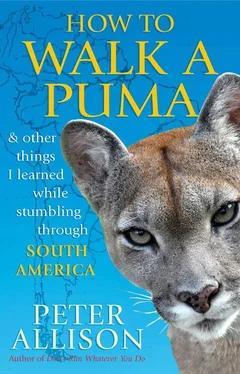The next day we spent four hours in the canoe, travelling downriver to a village called Bameno. In the seventies, this place had been an oil exploration camp, but the Huaorani drove the petroleros out (with spears) and took over the property to stop them returning, thus inheriting a gravel airstrip that they have maintained in rough form to this day.
The village, with maybe fifty inhabitants, was far busier than Otobo’s little spot upriver (which bears the confusingly similar name of Boanamo), and normally had only five or six inhabitants, swelling to ten if his wife arrived with their three children. (Otobo and his wife have two girls and a newborn son. ‘He has six fingers on each hand!’ Otobo told me proudly, ‘and six toes too!’ The toes, I might add, are on his feet where they should be.)
Everyone was related in some way, which might account for the occasional surfeit of fingers and toes, and the Huaorani as an ethnic group only number about two thousand individuals, as they have done for hundreds, even thousands, of years. This meant that if you made one enemy you made many, and as I am constantly making faux pas in my own culture I was quite nervous about offending someone here by accidentally making a gesture that signified: ‘Why yes, sir, I would very much like to have congress with your chicken!’ Fortunately the villagers of Bameno were nothing but friendly, and curious.
At the airstrip we said farewell to Quiet Chris, Mute Elizabeth and Stinky Fred, and hello to two new arrivals. Then we got naked.
Or at least three of us did, including me. In full Huaorani regalia—that is, nothing but a string, which I plan on wearing until it drops off (at the time of writing it still resolutely circles my waist)—we met the whole village, before making our way to the house of Omagewe’s father-in-law Quempere, the jaguar shaman. Among the Huaorani he is considered one of the most powerful spiritual leaders, and is believed to have access to spiritual realms and an ability to change into a jaguar at will. ‘I’d love to see that,’ I said to Otobo.
‘It doesn’t happen every day now like it used to,’ he explained.
‘Why not?’
‘He looks after his grandkids a lot now, and they piss on him.’
‘Oh,’ I said, not really sure what else to say.
Otobo sensed my confusion. ‘The jaguar spirit doesn’t like the smell, so stays away.’
‘Oh,’ I said again, and left it at that.
Despite his inability to shape shift, Quempere did give me the heartening news that he would send the spirit of a jaguar to the river’s edge, or somewhere in the forest where I would see it.
Then, being me, I dived into the Cononaco River which flows past the village, and swam about a kilometre. There was no real reason why I did it, but public nakedness had fostered a certain delirium, making me forget what I was offering as bait in waters that hold caiman, piranhas and the dreaded candiru.
That night we camped downstream, accompanied by several of the village elders. The new tourists included American Allan, an aspiring television presenter, and his cameraman Fernando, who delighted in the playful nature of the Huaorani men, particularly Otobo’s father. I had begun to think of the old man as the Amazing Omagewe. Despite his age he climbed trees as if they were ladders, laughing all the way, while I watched in admiration below, wanting to join in but fearing abrasions on areas that were already sensitive due to being sunburnt for the very first time.
That night we took a cruise in the canoe to look for caiman. I sat in the bow with a hefty Maglite, and eventually I made out a reasonable-sized caiman on a bank (Marcello would have undoubtedly called it ‘huge!’). On the way back I continued to shine the torch on the banks, and not far from our camp I hit eyeshine.
‘ Tigre! ’ shouted Otobo.
When the Spanish arrived in South America they decided that the large spotted cat they encountered was somehow the same as the huge striped one in Asia, so they called it ‘ tigre ’, though of course it wasn’t a tiger. So confusingly in South America tigre means jaguar. At Otobo’s shout I almost fell out of the canoe in excitement, peering with eye-straining intensity down the flashlight’s beam.
But this was not a jaguar. It was an ocelot. Roughly twice the size of a housecat with an intricately patterned coat and large eyes suited to nocturnal hunting, it blinked briefly at us then melted into the undergrowth. I felt momentarily deflated, before the optimism I’d learnt in the Pantanal with Marcello came straight back. It was a thrill to see the ocelot as it was the first truly wild cat I’d seen in South America. More would come, surely.
Even Huaorani Fear Someone

I had a fitful night after seeing the ocelot, a fever plaguing my sleep, making me shake under the thin sheet I used as a cover. Tom had suffered dengue fever the year before and said my symptoms were consistent with that disease, something that would require an evacuation, as the Huaorani had no facilities to care for me. I did not want to leave, and in the morning I felt well enough to go out with a group of Huaorani, including the Amazing Omagewe. Probably the happiest man I had ever met, he never stopped laughing or smiling, even when his more aged father-in-law, the jaguar shaman, wandered off into the forest that afternoon after a vision. Tom had explained to me that Quempere was showing signs of senility, so finding him was a priority.
‘Quempere! Woo hoo!’ Omagewe shouted, then laughed. ‘Quempere!’
I joined in with the calling, which for some reason Omagewe found hilarious, all four foot ten of him doubled over with laughter.
‘Woo hoo!’ we shouted together, and then we both cracked up. It reminded me how much communication can be done without language. Until that day I thought the sound of a champagne cork popping was the happiest sound on earth—now I know it is a group of Huaorani laughing.
We eventually found Quempere back at the canoe, baffled at our concern, using a palm frond as an umbrella against the rain, which was once more lashing down in diagonal streaks, so thick it was blinding. Back at the campsite we gathered at the fire, those of us who were naked standing closer than the others in a communal huddle, laughing at each other’s chattering teeth.
That night my fever came back, slow-roasting me for unknown hours until it broke and rivers of sweat soaked my skin. Then, after finally falling asleep (and dribbling into my pillow), I was woken by horrific wailing.
I sat up in shock. My first thought was that our campsite was under attack by the truly wild tribes of Ecuador: the Tagaeri and the Taromenane. The shadow of the two uncontacted tribes loomed over most conversations with Huaorani; they were spoken of with a mix of mythology, curiosity and fear. Everyone had a story about these two tribes that have no contact with the outside world at all; while most of the stories tell of harmless encounters, occasionally meetings can result in great violence. Some years earlier, Huaorani had killed twenty-three Tagaeri in revenge for deaths in their community, even though it turned out the Tagaeri were not responsible. The Huaorani believe that someone is responsible for every death, be it from illness, old age or an attack, and so all deaths must be avenged.
The Tagaeri are close relatives of the Huaorani, but Otobo’s family believe the Taromenane are not. As much as the Huaorani seemed completely at one with the forest, they described the Taromenane as being more adept than them in jungle craft, and spoke with a reverence of their abilities. Not long before my visit, Omagewe went hunting for several days, and left his wife alone at their hut in Boanamo. One night she went outside and saw a group of Taromenane standing at the edge of the field. According to her, they were tall and pale—‘as tall and white as you,’ she said in Huao, pointing at me. When they spoke she couldn’t understand them; she shouted back that they could take what they wanted from the field, then went back inside and waited, hoping not to be speared.
Читать дальше













